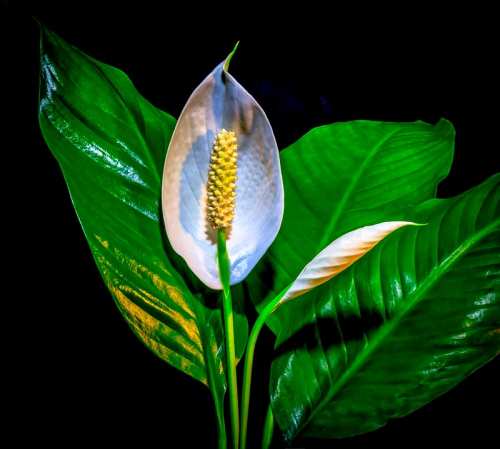Anyone who loves to build a backyard filled up with their favourite house plants would also recognize a spoon shaped, single petaled flower clubbed with large leaves. You guessed it right! We are talking about peace lilies.
Peace lilies are known to enhance the beauty of whichever place they are kept in, and belonging to tropical regions, they require conditions familiar to the region, in order to thrive.
If you have peace lilies growing in your backyard, then you might face a lot of issues and disturbances before yielding the best plant. How much sunlight does peace lily need? Will peace lilies survive without sunlight? Do peace lilies require water? These and so many more questions might pop up in your mind when entrusted with the responsibility of growing peace lilies.
However, we assure you, it is not that difficult as it sounds. In the preceding article, we would be directing our attention primarily to the light requirements of peace lilies. In our journey, we would also gain some knowledge about what peace lilies are and how you can grow and maintain them at your home.
Scroll through to end your quest of finding everything about peace lilies.
Related: How Long Can a Peace Lily Go Without Water?
Know your peace lily

Scientifically known as Spathiphyllum, peace lilies are native to American and Asian tropical regions. They are also famously known as spath, and are usually available by this name commercially.
These evergreen plants have lush green leaves which are about 12-65 cm long and 3-25 cm wide.
Since the plant is evergreen, it does not pose special demands for large amounts of water or sunlight regularly.
According to a study by NASA, peace lilies are responsible for cleaning specific gaseous contaminants from the environment they are placed in, like formaldehyde and benzene.
A surprising fact is that peace lilies do not really belong to the family of lilies and are therefore mildly toxic to ingestion by humans and animals, unlike true lilies which are highly poisonous.
Cats and some other animals can suffer from acute kidney failure if they consume a leaf or flower of peace lily.
Now that we have had an idea about peace lilies, let us jump to the most important question surrounding the light requirements of the plant.
Meeting the light requirements of a peace lily plant
As we have seen earlier, due to the nature and origin of the peace lily plant, they do not require excess sunlight. But, this little piece of information is not really something that we have been looking for, right?
We need in depth information about how much light they require, why is it so, and what are the possible sources. Let us dive in to know more!
Also Read: Overwatered Peace Lily: How to Revive Peace Lily
How Much Sunlight Does Peace Lily Need?
Sources of light indoors
If you happen to place your peace lilies indoors for growing purposes, chances are that it will receive indirect sunlight for most part of its life, while the rest of the requirements would be met by artificial indoor plant light sources. So, how to take care of your peace lily, if it is placed indoors?
The foremost important rule is to try and let the plant receive as much indirect sunlight as it can. For this purpose, you can place the plant near a south facing window, where the rays of sun fall directly into a spectrum of light. This kind of light will provide maximum benefit to your peace lily plant indoors.
Note that if your house does not have a south facing window, you can always opt for a north facing window, as the light falling from the direct is less intense but still useful for the plant. Do not worry if your windows do not catch a direct pathway of sunlight. Your plants will gain the maximum benefit when placed near windows, since the heat and effect there would be more intense, even if the rays do not fall directly.
If, at any point of time, you feel that your plant is not able to achieve maximum light from the window, you might want to look at other factors that are key in increasing, decreasing, or modifying the intensity of light.
Some of them are, the cleanliness of the window, colour of the wall, and placement and positioning of the mirrors. Some of the high school physics lessons go into understanding why these factors are important, how they influence light intensity, and how to select them.
Light coloured walls (preferably white or cream) and mirrors reflect the incoming sunlight and light up the potted plant placed right in front of them. This would not work if you place your plant in front of a dark coloured wall with no mirrors. Further, you can make use of the simple shadow test to know if your plant is achieving the appropriate proportion of light indoors or not.
Also Read: How to Revive a Dying Pothos Plant?
Sources of light outdoors
If you are placing peace lilies or any other plant outdoors, then there is only one source of light left, sunlight, probably direct. Anyway, here is what to do if you have decided to plant peace lilies outdoors. Primarily, place it somewhere where the sunlight does not fall directly throughout the day. You can select a sheltered porch, a patio, or a spot under your favourite tree, whatever you desire.
Make sure that you place it somewhere you have constant access and flexibility to change the directions and positions. As and when the night starts to set in, it is preferred to take the plants indoors. Peace lilies cannot tolerate temperatures below 60 degrees fahrenheit, therefore you should take special care of this when you place it outdoors.
Placing peace lilies outdoors cannot stop it from getting influenced by the weather and seasonal changes that take place throughout the year. Let us look at some specific seasonal considerations to grow peace lilies outside in the open.
Spring and Summer
During the spring and summer seasons, peace lilies do well when placed in low lighting conditions- however they do not thrive in those conditions. If you want the leaves, flowers, and the overall plant to achieve its maximum and best growth, it is ideal to move the light into a moderate to bright indirect sunlight receiving condition. It would help your plant bloom in no time.
If you feel that indoors, near the window is the perfect place for your plant to achieve the ideal amount of sunlight, then you can shift the plant anytime you want, for its betterment.
Also Read: Do Marigolds Keep Snakes Away?
Winter and Fall
As the seasons of autumn and winter kick in, peace lilies switch their demands from bright sunlight to low and moderate sunlight. Since it is difficult to predict the amount of sunlight in winters, it is preferable if you install artificial lights and make use of them for fulfilling the light requirements of your peace lily plant.
You can begin by installing a light fixture with two fluorescent bulbs hanging 10 to 12 inches above the plant. Make sure to set the timer on your light fixture such that your plant gets a steady amount of 16 to 18 hours of artificial light on a daily basis.
If the windows are giving excess sunlight, make sure to cover those with sheer and a light material curtain. Similarly, if placed outdoors, you can give your plant enough shade if the sun decides to bless the earth in that weather.
When the day reaches its brightest part, you can perform the shadow test with your hand to get shadows that are either too blurry or too edgy, according to the light that the plant receives. Make sure the former shadow on the wall or a sturdy surface is somewhere between the two.
Adjust the plant according to the amount of sunlight it achieves. This way you’d be able to test your peace lily for adequate sunlight in the most accurate and convenient way possible.
Also Read: Why Are the Leaves on My Christmas Cactus Drooping Leaves?
Do all types of peace lilies require the same amount of light?
Peace lilies come in various shapes and sizes. It would not be wrong to say that the light requirements differ for each peace lily. Below is a list of four of the most common species of peace lilies that are grown as houseplants, with the lighting requirements that each prefers.
You can check the light requirement of your plant according to the kind of peace lily you are growing.
Domino
The most commonly available, domino peace lily thrives and seeks out artificial light sources like fluorescent light. In short, it does not require direct sunlight and likes to stay away from it for most part of the day.
Office buildings or entrances are the ideal locations for placing Domino peace lilies for receiving adequate light, artificial or otherwise.
If placed indoors, Domino peace lilies do well in bright indirect sunlight coming from windows or window ledge. This is if the window is placed in the north eastern direction.
However, if placed in western or southern direction windows, the plants don’t do well in the falling indirect sunlight. If the houseplant is kept 8 to 10 inches away from the window or the window is sheltered appropriately, then the plant is not affected as such.
Overall, bright and indirect light will yield more flowers in a domino peace lily than no light.
Mauna Loa
Like its counterparts, maunaloa peace lily will yield blooming flowers under moderate light. In too low or severely high light, the plant either gets no flowers or gets bleached. West and east facing windows should be preferred for keeping maunaloa peace lilies.
Sweet Pablo
Locate a perfect spot near the window and place your sweet pablo peace lily variety on that spot. Keep it in a well lit area, away from direct sunlight.
Sensation
Low to moderate light are the most appropriate lighting conditions that supports the growth of sensation peace lily plants. Keep it away from dark areas, and relocate it at a place that receives bright and indirect sunlight.
It is advised to keep the plant away from direct sunlight, since they can cause specific harm to its sensitive leaves.
What happens when the plant gets inappropriate light?
There might be times when your peace lily is not able to get adequate sunlight. How will you know? Here are two prominent symptoms that would help you mark lighting abnormalities within your plant.
Scarce flowers
Low light conditions do not provide enough impetus for the plants to bloom, creating a condition of closet plants.
Brown leaves
Too much light can cause the foliage of peace lilies to turn brown. This is a sign of leaf burn which results from the scorching heat of direct sunlight.
Conclusion
Usually grown as houseplants, peace lilies can sometimes fail to attain the adequate nutrition and survival necessities which would have been present otherwise. Nevertheless, if one really desires to grow the perfect peace lily, then they should be ready to go an extra mile for the same.
The aforementioned tips and information have been gathered from empirical research studies. If followed rightfully, the effort will not go in vain.
Happy gardening!
